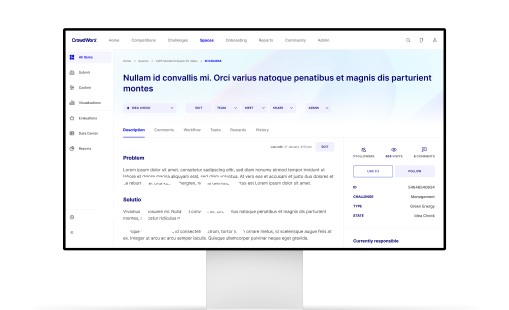Innovation without measurement is just organized chaos. You might be generating hundreds of ideas across your organization, but how do you know if your innovation efforts are actually driving results?
The answer lies in tracking the right metrics throughout your entire idea management funnel. At Crowdworx, we’ve seen organizations transform their innovation performance simply by implementing the right measurement framework. When you can see what’s working – and what isn’t – you can optimize every stage from idea generation to market impact.
This guide will walk you through the essential metrics that turn your innovation process from a black box into a transparent, accountable system that delivers measurable business value.
Understanding Your Idea Management Funnel
Before diving into metrics, let’s clarify what we mean by the idea management funnel. It’s the systematic process that guides ideas from initial generation through to real-world implementation and impact.
Think of it as a filtering system where ideas progressively move through defined stages, each with specific evaluation gates and criteria. This structure ensures that only the most promising ideas receive resources and attention.
A well-structured funnel typically includes these key stages:
Idea Generation – Collecting ideas from employees, customers, and external partners aligned with your strategic priorities
Idea Development – Refining concepts through collaboration, feedback, and structured improvement processes
Evaluation – Scoring ideas against criteria like feasibility, strategic fit, and potential business impact
Selection & Prioritization – Choosing which ideas to pursue based on available resources and expected returns
Prototyping & Testing – Creating pilots and proof-of-concepts to validate assumptions and reduce risk
Implementation – Executing validated ideas into real products, services, or process improvements
Impact Tracking – Measuring the business value generated by implemented innovations
Without clear metrics at each stage, you’re essentially flying blind. You might have great ideas, but no way to identify bottlenecks, prove ROI, or continuously improve your innovation process.
Why Measuring Each Stage Matters
Here’s a sobering reality: less than 10% of ideas typically make it past early evaluation stages. Without proper measurement, you can’t identify why promising concepts get stuck, where your process breaks down, or which improvements would have the biggest impact.
Tracking idea metrics throughout your funnel provides several critical advantages:
- Visibility into participation patterns – See which teams are engaging and where you need to boost involvement
- Bottleneck identification – Pinpoint exactly where ideas get stuck and why conversion rates drop
- Speed optimization – Measure cycle times to accelerate your innovation process
- Strategic alignment – Ensure innovation efforts support your business objectives
- Stakeholder credibility – Demonstrate concrete progress and ROI to secure continued investment
The most effective measurement approaches balance leading indicators (like participation rates and evaluation speed) with lagging indicators (like revenue from new products). Together, they create a complete picture of your innovation health.
Essential Metrics for Each Funnel Stage
1. Generation & Participation Metrics
At the top of your funnel, focus on quantity, quality, and engagement:
Idea Submission Rate – Average ideas submitted per employee per month (benchmark: 0.5-1.0 ideas per employee)
Participation Rate – Percentage of employees actively contributing ideas (target: 60-75% platform engagement in first month)
Source Diversity – Distribution of ideas across departments, external partners, and customer inputs
Idea Quality Score – Average evaluation score of submitted ideas (shows improving idea quality over time)
These metrics reveal whether you’re successfully activating your organization’s creative potential. Low participation might indicate unclear strategic focus, insufficient communication, or cultural barriers to innovation.
2. Evaluation & Development Metrics
Once ideas are submitted, track how effectively you process and improve them:
Average Evaluation Time – Days required to review and provide feedback on each idea
Collaboration Intensity – Comments, votes, and contributions per idea (healthy benchmark: 3+ comments per idea)
Development Rate – Percentage of ideas that receive structured improvement before evaluation
Strategic Alignment – Share of ideas that clearly connect to defined strategic search fields
Slow evaluation times create bottlenecks and discourage participation. High collaboration intensity indicates strong engagement and typically leads to better-developed concepts.
3. Selection & Approval Metrics
These metrics show how well you identify and prioritize your best opportunities:
Stage Conversion Rates – Percentage of ideas advancing from each stage to the next
Approval Ratio – Ideas approved for further development divided by total submissions
Portfolio Balance – Distribution across incremental, adjacent, and breakthrough innovation types
Resource Allocation Efficiency – Investment alignment with strategic priorities and expected returns
Poor conversion rates might indicate overly strict criteria, while consistently high approval rates could suggest insufficient filtering.
4. Implementation & Execution Metrics
The true test of your innovation process lies in execution:
Implementation Rate – Approved ideas that actually reach market or operational deployment (benchmark: 15-25% of approved concepts)
Time to Market – Duration from idea approval to full implementation
Budget Adherence – Percentage of innovation projects delivered within planned resources
Prototype Success Rate – Concepts that successfully transition from pilot to full implementation
These metrics reveal your organization’s ability to turn validated ideas into reality. Long implementation times or high project failure rates often indicate resource constraints or execution challenges.
5. Business Impact & ROI Metrics
Finally, measure the business value generated by your innovation efforts:
Innovation ROI – Revenue and cost savings generated compared to innovation investment
Revenue from New Products – Percentage of total revenue from products/services launched in past 3-5 years
Process Innovation Savings – Cost reductions achieved through operational improvements
Customer Impact Metrics – Net Promoter Score, satisfaction scores, or retention rates for new offerings
Market Share Growth – Competitive position improvements driven by innovation
These lagging indicators prove whether your innovation process creates genuine business value and justify continued investment.
Common Measurement Mistakes to Avoid
Even well-intentioned measurement efforts can backfire. Here are the critical mistakes we see organizations make:
Measuring Vanity Metrics – Counting idea submissions without tracking implementation creates “idea graveyards” that frustrate employees and waste resources.
One-Size-Fits-All Approach – Breakthrough innovations need different metrics than incremental improvements. Use context-appropriate measures.
Ignoring Process Health – Focusing only on outcomes while neglecting conversion rates, cycle times, and collaboration metrics misses optimization opportunities.
Misaligned Incentives – If your performance reviews don’t reflect innovation metrics, employees will prioritize other activities.
Inconsistent Tracking – Sporadic measurement makes it impossible to identify trends or validate improvements.
The key is building a balanced scorecard that tracks both innovation process health and business impact, with clear accountability and regular review cycles.
Turning Metrics into Action
Collecting data is just the first step. The real value comes from using metrics to continuously improve your innovation process.
Start by establishing baseline measurements across your current funnel. Identify your biggest bottlenecks and lowest-performing stages. Then implement targeted improvements – whether that’s better strategic communication, faster evaluation processes, or stronger implementation support.
Regular review cycles ensure your measurement framework stays relevant as your innovation process matures. What matters most in year one might be less critical in year three as your organization builds innovation capabilities.
Building Your Innovation Measurement Framework
A comprehensive measurement approach transforms innovation from an art into a disciplined business process. Input metrics show how well you’re feeding the funnel, process metrics reveal operational efficiency, and outcome metrics prove business impact.
The metrics outlined in this guide – from submission rates to innovation ROI – create a framework for continuous improvement. By avoiding common measurement pitfalls and focusing on actionable data, you can build a sustainable innovation engine that consistently delivers measurable results.
Success means more than just generating ideas. It means systematically turning those ideas into implemented innovations that create tangible business value. With the right measurement framework, your organization can achieve exactly that – innovation that truly drives competitive advantage.

